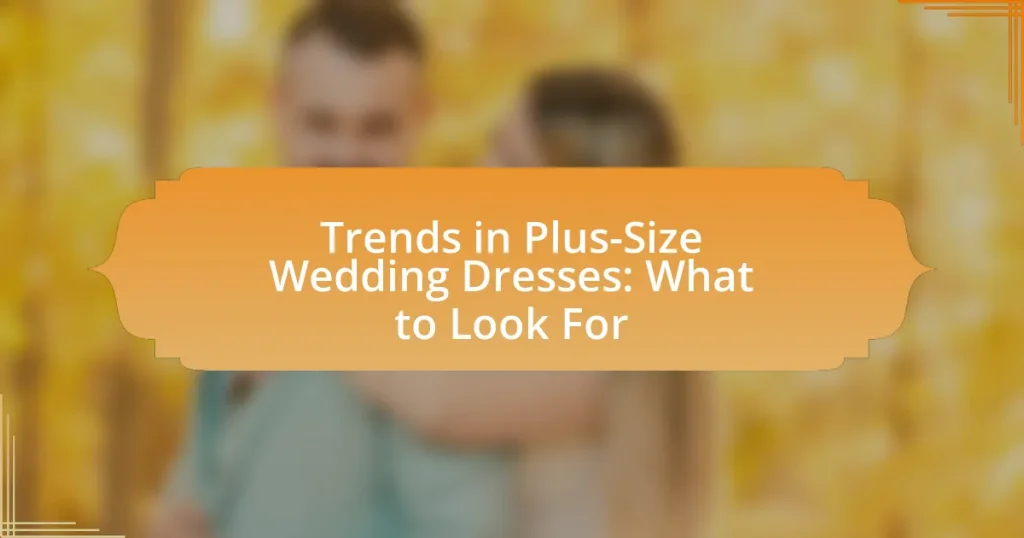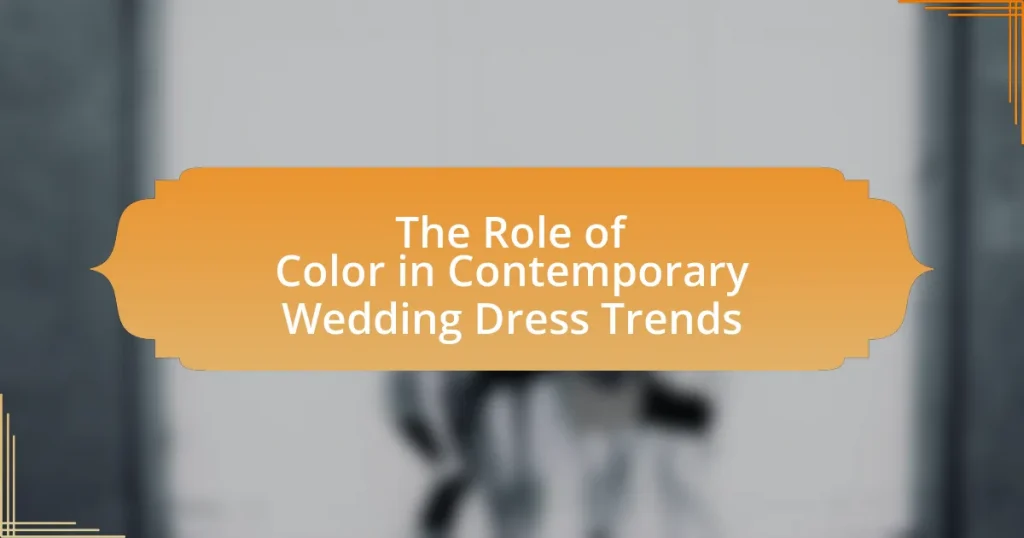Lace plays a crucial role in wedding dress styles, symbolizing elegance, tradition, and femininity. Historically associated with wealth and status, lace enhances the aesthetic of bridal attire through its intricate patterns and textures, making it a timeless choice for brides. The article explores the historical significance of lace, its cultural influences, and how its perception has evolved over time. It also examines the various types of lace used in wedding dresses, the advantages of specific lace types, and contemporary design techniques that incorporate lace into modern bridal fashion. Additionally, the article addresses maintenance considerations and tips for brides when selecting lace to ensure longevity and a perfect match for their wedding theme.
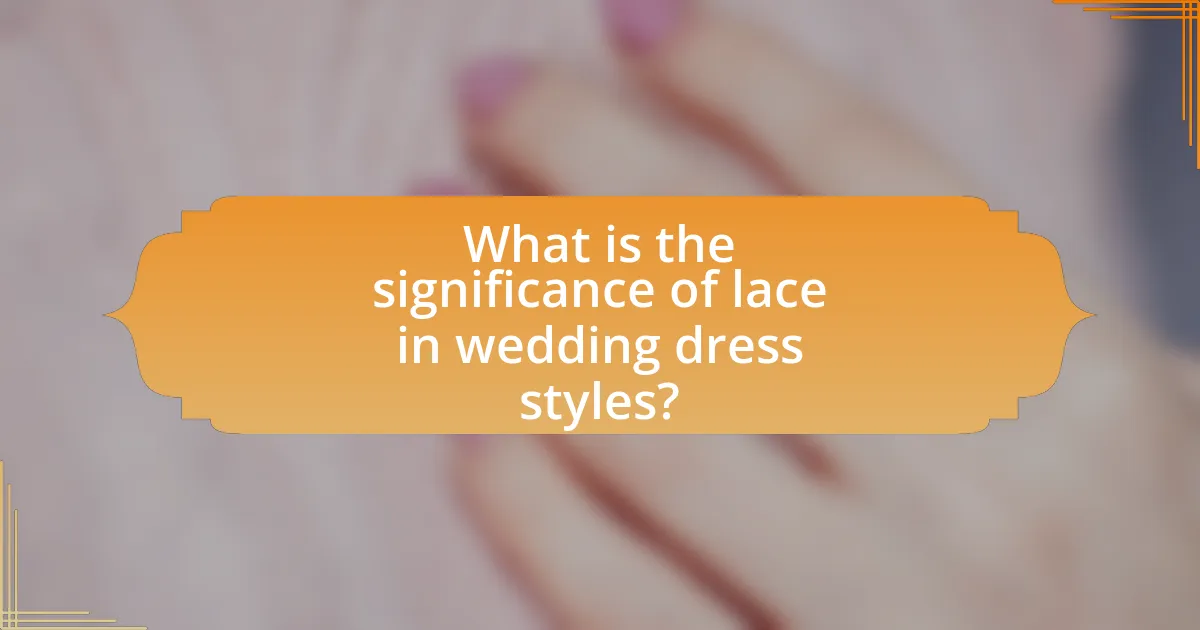
What is the significance of lace in wedding dress styles?
Lace holds significant importance in wedding dress styles as it symbolizes elegance, tradition, and femininity. Historically, lace has been associated with wealth and status, often used in royal and aristocratic garments, which enhances its appeal in bridal fashion. The intricate patterns and textures of lace add depth and visual interest to wedding dresses, making them more romantic and ethereal. Additionally, lace is versatile; it can be incorporated into various styles, from vintage to modern, allowing brides to express their personal style while adhering to the timeless nature of wedding attire.
How has lace been historically used in wedding dresses?
Lace has historically been used in wedding dresses to symbolize elegance and femininity, enhancing the overall aesthetic of bridal attire. Originating in the 16th century, lace became a popular embellishment in wedding gowns, particularly in Europe, where it was associated with wealth and social status. The intricate designs and delicate nature of lace allowed for a romantic and ethereal quality in bridal fashion, making it a favored choice among brides. By the 19th century, lace was commonly incorporated into wedding dresses, with notable examples including Queen Victoria’s lace-trimmed gown in 1840, which set a trend for future brides. This historical significance of lace in wedding dresses underscores its enduring appeal and role in creating timeless styles.
What cultural influences have shaped the use of lace in bridal fashion?
The use of lace in bridal fashion has been shaped by various cultural influences, particularly from European traditions. In the 16th century, lace became a symbol of wealth and status in countries like France and Italy, where intricate lacework was often incorporated into wedding attire to signify the bride’s family affluence. Additionally, the Victorian era popularized lace in bridal gowns, as Queen Victoria’s wedding to Prince Albert in 1840 featured a white lace dress, setting a trend that emphasized purity and elegance. This cultural significance of lace has persisted, with modern bridal fashion often reflecting these historical influences, showcasing lace as a timeless element that embodies romance and sophistication in weddings across different cultures.
How has the perception of lace evolved over time in wedding attire?
The perception of lace in wedding attire has evolved from a symbol of wealth and status to a versatile and romantic fabric embraced by brides of all backgrounds. Historically, during the 16th and 17th centuries, lace was an expensive luxury, often used by the aristocracy to signify social standing. In the 19th century, Queen Victoria popularized lace in wedding dresses, particularly with her choice of a white lace gown, which shifted its perception to a staple of bridal fashion. By the 20th century, lace became more accessible due to advancements in textile manufacturing, allowing it to be incorporated into a wider range of wedding styles, from traditional to modern. Today, lace is celebrated for its intricate designs and ability to add elegance and femininity to wedding dresses, making it a timeless choice for brides worldwide.
Why is lace considered a timeless element in wedding dress design?
Lace is considered a timeless element in wedding dress design due to its intricate patterns and delicate texture, which evoke elegance and romance. Historically, lace has been used in bridal fashion since the 16th century, symbolizing wealth and sophistication, as seen in royal weddings. Its versatility allows it to complement various styles, from vintage to modern, making it a perennial favorite among brides. The enduring popularity of lace is evidenced by its consistent presence in fashion trends and its ability to enhance the beauty of any gown, ensuring that it remains a classic choice for weddings across generations.
What qualities make lace a preferred choice for brides?
Lace is a preferred choice for brides due to its elegance, versatility, and intricate detailing. The delicate patterns and textures of lace add a romantic and timeless quality to wedding dresses, enhancing the overall aesthetic. Additionally, lace can be easily incorporated into various styles, from vintage to modern, making it suitable for diverse bridal preferences. The historical significance of lace in bridal fashion further solidifies its status; it has been a symbol of luxury and sophistication since the 16th century, often associated with nobility and high fashion. This rich heritage contributes to its enduring appeal among brides seeking a classic yet stylish look for their special day.
How does lace contribute to the overall aesthetic of a wedding dress?
Lace enhances the overall aesthetic of a wedding dress by adding texture, elegance, and a sense of romance. The intricate patterns and delicate nature of lace create visual interest and depth, elevating the dress from a simple garment to a statement piece. Historically, lace has been associated with luxury and sophistication, often used in bridal fashion to symbolize purity and tradition. Its versatility allows it to be incorporated in various styles, from vintage to modern, making it a timeless choice for brides. The use of lace can also highlight the silhouette of the dress, drawing attention to key features such as the neckline or sleeves, thereby enhancing the overall design.
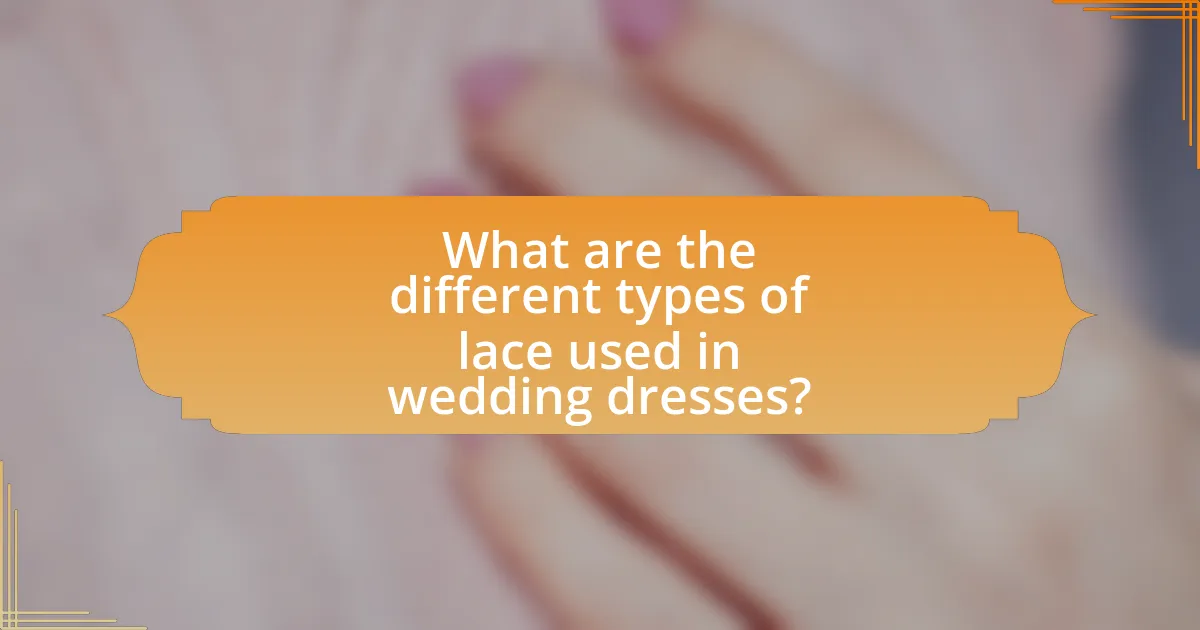
What are the different types of lace used in wedding dresses?
The different types of lace used in wedding dresses include Chantilly lace, Alençon lace, Guipure lace, and Venice lace. Chantilly lace is known for its delicate floral patterns and fine netting, often used for overlays. Alençon lace features a raised design and is typically used for intricate detailing. Guipure lace is characterized by its heavy embroidery and open weave, providing a bold look. Venice lace, often used for embellishments, is known for its intricate motifs and is typically heavier than other laces. Each type of lace contributes uniquely to the overall aesthetic and style of wedding dresses, enhancing their elegance and timeless appeal.
What are the most popular lace types for bridal gowns?
The most popular lace types for bridal gowns include Chantilly lace, Alençon lace, and Guipure lace. Chantilly lace is known for its delicate floral patterns and fine netting, making it a favorite for romantic and vintage-inspired gowns. Alençon lace features a heavier, embroidered design with a raised pattern, often used for a more opulent look. Guipure lace, characterized by its bold motifs and open weave, adds texture and depth to bridal designs. These lace types are widely chosen for their aesthetic appeal and ability to enhance the elegance of wedding dresses.
How does each type of lace differ in texture and appearance?
Different types of lace vary significantly in texture and appearance. For instance, Chantilly lace is known for its delicate, intricate floral patterns and soft, lightweight feel, making it ideal for elegant overlays. In contrast, Alençon lace features a heavier, more structured design with a raised cord outlining the motifs, providing a more opulent look. Venetian lace is characterized by its bold, elaborate designs and thicker texture, often used for dramatic effects. Lastly, embroidered lace combines lace with additional embroidery, resulting in a rich texture and a more dimensional appearance. Each type of lace contributes uniquely to the overall aesthetic of wedding dresses, enhancing their timeless appeal.
What are the advantages of using specific lace types in wedding dresses?
Specific lace types in wedding dresses offer advantages such as enhanced aesthetic appeal, texture, and versatility. For instance, Chantilly lace is known for its delicate floral patterns and lightweight feel, making it ideal for romantic and vintage-inspired designs. Alençon lace, characterized by its raised corded design, adds a luxurious texture and is often used for more formal styles. Additionally, lace can be layered or combined with other fabrics, allowing for creative customization in wedding dress designs. The use of lace also evokes tradition and elegance, which are significant factors in wedding attire, reinforcing its timeless appeal.
How do designers incorporate lace into modern wedding dress styles?
Designers incorporate lace into modern wedding dress styles by using it as a key element for texture, elegance, and intricate detailing. Lace is often layered over other fabrics to create depth and visual interest, while also being used in various forms such as appliqués, trims, and full lace gowns. The versatility of lace allows designers to blend traditional and contemporary aesthetics, appealing to diverse bridal preferences. For instance, the use of Chantilly lace or Alençon lace can evoke a vintage feel, while geometric lace patterns can modernize the overall look. This incorporation not only enhances the beauty of the dress but also aligns with current trends that favor romantic and feminine silhouettes.
What design techniques enhance the beauty of lace in bridal fashion?
Design techniques that enhance the beauty of lace in bridal fashion include layering, intricate embroidery, and strategic placement. Layering lace over different fabrics creates depth and texture, while intricate embroidery adds visual interest and highlights the lace’s delicate patterns. Strategic placement of lace, such as along hemlines or bodices, draws attention to specific areas of the gown, enhancing the overall silhouette. These techniques are supported by the fact that bridal designers often utilize lace to evoke elegance and sophistication, making it a timeless choice in wedding dress styles.
How do contemporary trends influence the use of lace in wedding dresses?
Contemporary trends significantly influence the use of lace in wedding dresses by promoting innovative designs and diverse applications. Modern bridal fashion emphasizes personalization and unique aesthetics, leading designers to incorporate lace in various forms, such as intricate overlays, bold patterns, and mixed materials. For instance, the rise of bohemian and vintage styles has increased the popularity of lace, as brides seek romantic and ethereal looks that lace can provide. Additionally, sustainability trends encourage the use of vintage lace or eco-friendly materials, aligning with the growing demand for environmentally conscious fashion choices. This shift reflects a broader movement in the fashion industry towards inclusivity and individuality, making lace a versatile and timeless choice in contemporary wedding dress design.
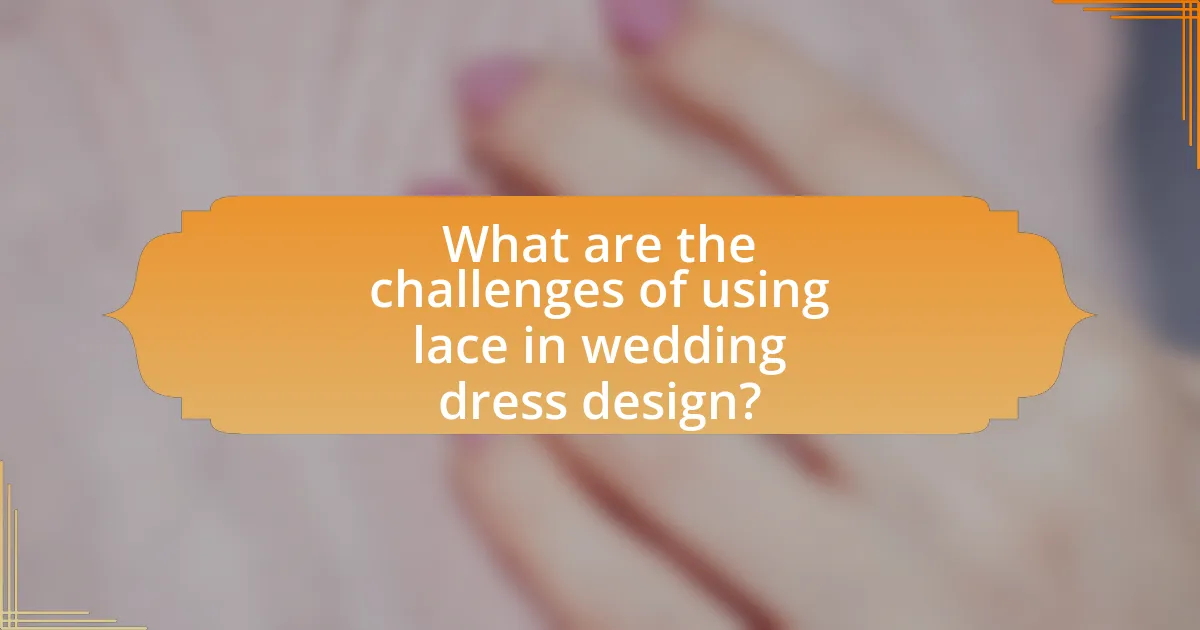
What are the challenges of using lace in wedding dress design?
The challenges of using lace in wedding dress design include its delicate nature, which can lead to fraying and damage, and the difficulty in achieving a perfect fit due to its varying stretch and weight. Lace is often intricate and requires careful handling during construction, as any mistakes can be difficult to correct. Additionally, sourcing high-quality lace can be challenging, as not all lace types are suitable for wedding dresses, impacting the overall aesthetic and durability. The complexity of lace patterns can also increase production time and costs, making it a more demanding material to work with in bridal fashion.
What maintenance considerations should brides keep in mind with lace dresses?
Brides should ensure proper care and maintenance of lace dresses to preserve their delicate fabric and intricate designs. Regularly inspect the lace for any signs of fraying or damage, as lace is prone to snagging. When cleaning, it is advisable to use a gentle detergent and cold water, as hot water can cause the lace to shrink or lose its shape. Additionally, brides should avoid hanging lace dresses for long periods, as this can stretch the fabric; instead, store them flat or in a breathable garment bag. For any stains, prompt treatment is essential, as letting stains set can lead to permanent discoloration. These maintenance practices help maintain the integrity and beauty of lace dresses, ensuring they remain timeless pieces.
How can brides ensure the longevity of lace in their wedding attire?
Brides can ensure the longevity of lace in their wedding attire by properly caring for and storing the fabric. Regularly cleaning lace with a gentle hand wash using mild detergent prevents dirt and oils from degrading the fibers. Additionally, storing the wedding dress in a cool, dry place, away from direct sunlight, helps prevent discoloration and deterioration. Using acid-free tissue paper to wrap the lace can also protect it from creasing and environmental damage. These practices are supported by textile conservation guidelines, which emphasize the importance of proper maintenance for preserving delicate fabrics like lace.
What common issues arise with lace and how can they be addressed?
Common issues that arise with lace include fraying, discoloration, and difficulty in cleaning. Fraying can be addressed by using a fray check solution or by carefully stitching the edges to prevent further unraveling. Discoloration often occurs due to exposure to light or improper storage; this can be mitigated by storing lace in a cool, dark place and using acid-free tissue paper for protection. Cleaning lace requires gentle methods; hand washing in cold water with mild detergent is recommended to preserve its integrity. These solutions are supported by textile care guidelines that emphasize the importance of proper maintenance for delicate fabrics.
What tips can brides follow when choosing lace for their wedding dress?
Brides should consider the type of lace that complements their wedding dress style and personal aesthetic. Different lace types, such as Chantilly, Alençon, and Guipure, offer varying textures and patterns that can enhance the overall look. For instance, Chantilly lace is known for its delicate floral patterns, making it ideal for romantic styles, while Alençon lace features a raised design that adds elegance to classic silhouettes. Additionally, brides should pay attention to the lace’s weight and drape, as heavier laces may not work well with lighter fabrics. Choosing lace that matches the dress’s silhouette and fabric ensures a cohesive appearance. Finally, brides should also consider the lace’s color, as ivory and white shades can significantly impact the dress’s overall tone and style.
How can brides select the right lace to match their wedding theme?
Brides can select the right lace to match their wedding theme by considering the style, texture, and color of the lace in relation to the overall aesthetic of the wedding. For example, intricate lace patterns like Chantilly or Alençon can complement a vintage or romantic theme, while simpler lace styles may suit a modern or minimalist wedding. Additionally, brides should evaluate the color of the lace; ivory or cream laces often align well with traditional themes, while colored laces can enhance a more contemporary or eclectic theme. The choice of lace should also reflect the season; lighter, airy laces are ideal for spring and summer weddings, while heavier laces can be more suitable for fall and winter events.
What should brides consider regarding lace patterns and styles for their body type?
Brides should consider that different lace patterns and styles can enhance or detract from their body type. For example, intricate lace patterns can add volume and texture, making them suitable for brides with a slender frame, while simpler, larger lace motifs can create a streamlined look, ideal for curvier body types. Additionally, the placement of lace can influence the perception of body shape; vertical lace designs can elongate the figure, while horizontal patterns may widen it. Understanding these dynamics allows brides to choose lace that complements their unique silhouette, ensuring a flattering and harmonious appearance on their wedding day.

